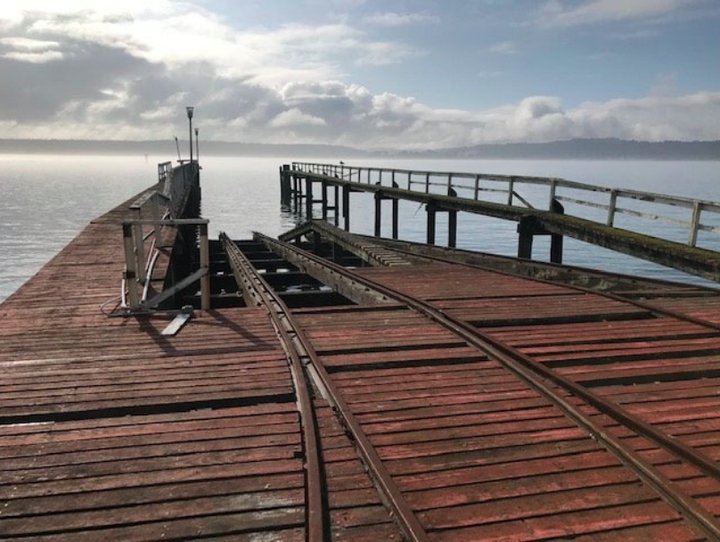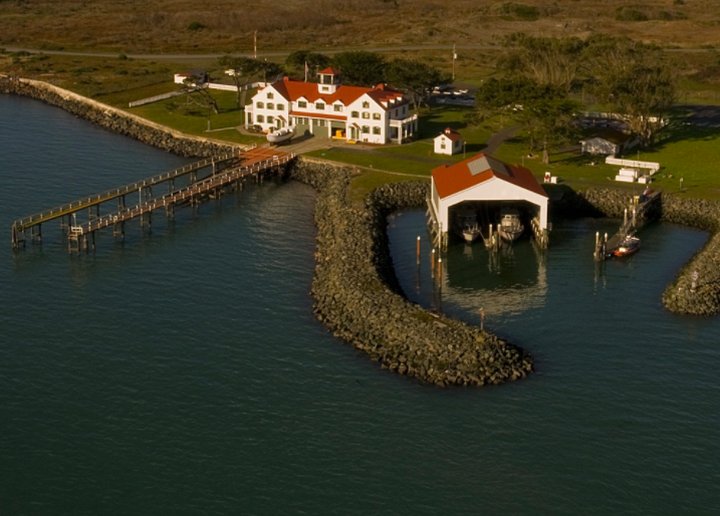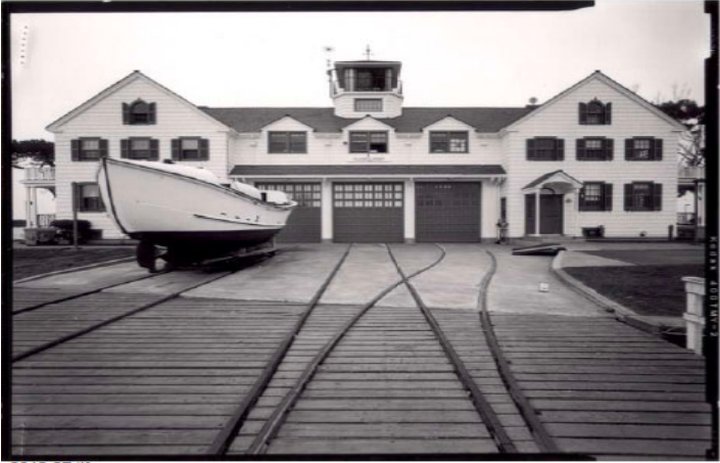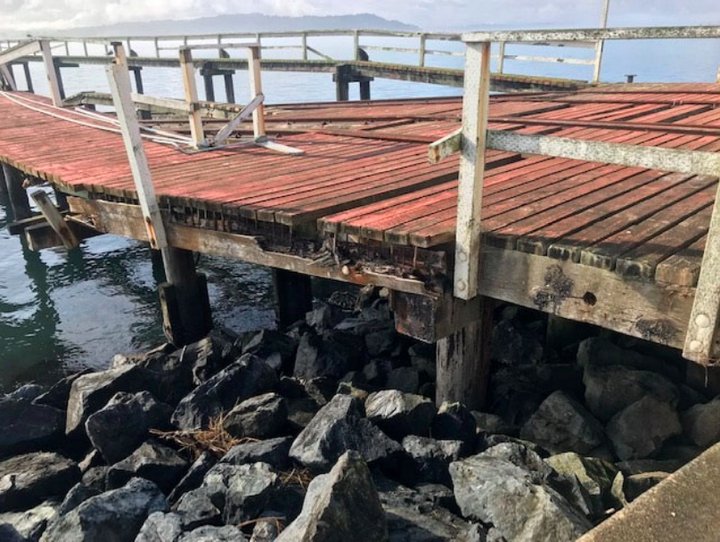
The marine railway, a defunct ramp once used to raise and lower lifeboats at Coast Guard Station Humboldt Bay. | Photos courtesy United States Coast Guard.
# # #
Back in April, the United States Coast Guard issued a notification informing interested parties that it plans to remove the marine railway, a defunct piece of lifesaving infrastructure, from Coast Guard Station Humboldt Bay.
For roughly 30 years following its construction during FDR’s first presidential term, the wood-and-steel ramp was used to haul lifeboats into and out of the bay. From 1937 through 1966, station personnel saved the lives of more than 300 people — mostly mariners who’d capsized in the turbulent mouth of Humboldt Bay — and they couldn’t have done so without the marine railway.
But according to the USCG, the structure has become a safety hazard, its planks and piles rotted, its steel beams corroded, the whole thing teetering on the verge of collapse.
“It is no longer safe for anyone to access, as planks and beams have collapsed into the water,” the notification reads.
This came as unwelcome news to local history buffs, including Jim Garrison, an archivist at the Humboldt County Historical Society. After reading the Coast Guard’s notification, which includes an overview of the marine railway’s historic properties, Garrison was ticked off, he recently told the Outpost. In fact, he’s still ticked off.
“It says right in there the importance of the thing,” he said. “This thing is enormously historically important to this area.”
Indeed, both the station building and the marine railway were added to the National Register of Historic Places in 1977. The building, which is sometimes called the Humboldt Bay Life-Saving Station, was constructed in 1936, replacing the original station constructed in the same spot, at the southern end of the Samoa Peninsula, in 1878.

Coast Guard Station Humboldt Bay on the south end of the Samoa Peninsula. The station’s current lifeboats can be seen inside the boathouse on the right. | Source.
The Coast Guard says its station at Humboldt Bay is “the best example in the western United States” of stations built in the “Roosevelt Style,” a form of Colonial Revival architecture employed by the Armed Services branch from the 1920s through the late 1940s.
Historian Ralph Shanks called this building “the apex of Coast Guard architecture,” and the Coast Guard’s April report notes that the detailing, “such as the period exterior door and window moldings, classical columns, balustrades, gable brackets and ironwork, is especially fine.”
As for the marine railway, these ramps were a design hallmark of the Roosevelt Style Coast Guard stations. An informational report attached to the Coast Guard’s notification described how it worked:
Launching the boat involved lowering it down the railway to the water in a cart connected to a gasoline-powered motor winch inside the building. Men on the walkways on each side of the rails would steady the boat on the cart with handling lines as it was lowered into the water. The boat was backed down the ramp so its motor entered the water first. The boat would float off the cart as the cart followed the rails into the water. When the boat returned, it was settled on the cart (posts on each side of the cart helped guide it) and the winch would pull the cart with the boat back to the boat room.

An old photograph showing the three-bay boat room at the Humboldt Bay Life-Saving Station and the rail lines leading to the marine railway. | Photo via USCG.
During this period in history, the Coast Guard used 36-foot lifeboats that had been modified to fit into the carts of marine railways. By the 1970s, the Coast Guard had switched over to 44-foot steel lifeboats, which were too large and too heavy to store in the station’s boat room and load onto the cart.
Humboldt Bay is now the only operating Coast
Guard station on the West Coast with a marine railway.
“The marine railway is really the most important part of that [station],” Garrison said. “It’s the last one!”
He’s hoping that demolition and removal can be avoided. After learning of its planned destruction he sent a letter to Rep. Jared Huffman, and he’s been commiserating with likeminded locals.
“I tell ya, it’s got a lot of us in the historical-minded community pretty fired up,” Garrison said. He’s hoping a wave of public support will help his cause.
Fellow historian Ray Hillman drafted a response letter to the Coast Guard on behalf of the Humboldt Bay Maritime Museum, suggesting that maybe part of the structure can be salvaged.
“I recommended they save the concrete apron where the rails are still embedded and also preserve maybe the first 20 to 40 feet of the trestle that brought the rails down to water itself,” Hillman told the Outpost in a recent phone interview.
Unlike Garrison, Hillman doesn’t hold out much hope for preserving the whole thing. “They [the Coast Guard] have enough good work to do besides working on something they don’t use,” he said. But he does believe that keeping a portion of it around would allow future generations to appreciate its significance.

The marine railway’s railings have crumbled, its wood plank decking has warped and its creosote-coated piling are rotting.
BMCM Chris Hinote is currently stationed at Humboldt Bay. He told the Outpost that he’s “the middle man” between the brass that’s working on the removal project and his fellow search and rescue personnel stationed here. He said the marine railway poses both safety and environmental dangers.
“I’m a straight shooter; I don’t sugarcoat much stuff,” he said. Asked what it would take to salvage the marine railway he responded, “To be honest with you, man, at the end of the day it’s gonna take money. And the Coast Guard doesn’t have money for it.”
While the Coast Guard “loves historical stuff,” he said, the bottom line is that the marine railway serves no operational function. And according to the Coast Guard’s own report, its collapse — say, during a powerful storm — could release debris that could damage the station building and jeopardize navigational safety on the bay.
Furthermore, the rotting wooden pilings are coated in creosote, a hazardous material that’s polluting the waters of Humboldt Bay and the sediment below, according to the report.
Leroy Zerlang, a longtime board member at the Humboldt Maritime Museum, feels that the whole situation is sad. “I mean, it’s a way of life that’s long gone,” he said. But at the same time he’s not too sentimental about the structure.
“It’s in such poor shape that if you tried to [repair it] — you know the old saying, ‘I’ve got my grandfather’s ax. The handle’s been replaced twice, and the head once’?” he said. “I picked a piece out of the water the other day. I really honestly don’t believe that it can be saved, as much as I believe it’s so historical.”
Zerlang hasn’t even sent the letter Hillman drafted for the museum. Instead, he’s focused on rescuing and restoring a 36-foot lifeboat that’s currently parked outside Station Humboldt Bay. “It’s got a helluva history here,” Zerlang said. “If I work on saving it, it will be my third time.”
The Coast Guard is still in the early planning stages of the removal project. Officials haven’t identified a timeline or even a method for completing the deconstruction and removal.
Zerlang, meanwhile, said the old wooden-hulled lifeboat he’s trying to rescue is exactly the type of vessel that was used on the marine railway — a piece of history from that period that may yet be salvaged.
CLICK TO MANAGE